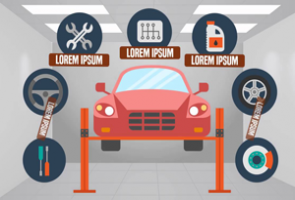You might have already noticed just how many blue-collar industries are turning to platforms like YouTube and Vimeo to promote their businesses. This is true in almost any industry, from HVAC to plumbing to even auto repair. There are loads of how-to and DIY videos out there that are being developed by companies like yours, and they exist for two specific purposes.
First, they show the consumer the processes that go into both simple and complex installations and repairs. They help the savvier among us save some money by doing things themselves, and they encourage the less knowledgeable or adventurous to seek the help of the pros in their time of need.
Today, I would like to zero in on a specific type of auto repair marketing content that I think would benefit your business tremendously: explainer videos. I believe that this is an underused area of content marketing within the automotive industry, which would place your business at an advantage if you started producing them now.
Based on the types of content that are being offered within the automotive industry right now, I think it’s safe to say that developing explainer videos is one of the most effective marketing strategies for auto repair shops there currently is, and the format, structure, and process of producing this kind of content are definitely worth your attention.
Explainers differ from how-to and DIY videos in that they focus more on the why than they do on the what. Think of it as the difference between “How to Recharge Your Vehicle’s AC Unit” and “Why You Need to Get Your Vehicle Ready for Summer.”
Even better, you can pair this type of video content with blog content that gives viewers an even deeper perspective on why they should take your advice. We’ll get into blogging in another article. For now, let’s learn more about these explainer video things…
The Purpose of an Explainer Video
The goal of an explainer is to show viewers that you have the knowledge and expertise to solve one specific problem. They are often short (about a minute or so) and provide a bare-bones outline of a given subject. They answer some common questions but leave room for further discussion or explanation, typically found by clicking through to a landing page, tapping to call the shop directly, and so on.
You don’t want to get into all the causes of a car’s air conditioning going warm or ceasing to function all together in an explainer. Rather, you want to briefly explain the process of repairing or maintaining the system in the event that something has gone wrong or to prevent something from going wrong.
The short length of an explainer gives you a great opportunity to drive the sense of urgency involved with taking action. If you can touch on things the consumer fears about what can happen to their car if they ignore your advice, you will get through to them and motivate them to contact you. That, in short, is the basic point of your explainer.
The Anatomy of an Explainer Video
As I mentioned earlier, the best explainers are those that zero in on one specific problem and offer a solution. In marketing terms, we call these “pain points.” Anyone who has ever been on a long trip and had their AC give out halfway knows what a pain it can be. If you lead with that, you will have their attention from the get-go.
The next step is to assure viewers that there are ways to prevent this terrible thing from happening to them or that a solution to the problem exists if it is already an issue they are experiencing.
The final step is to direct viewers to where they can get the solution implemented. Again, this usually involves getting them to contact you in one way or another. You accomplish this with a clear call to action. In short, you have to tell viewers what to do next given the information you’ve provided. Follow this formula, and you are likely to get some very positive results.
Developing an Explainer Video
I always recommend spending a little bit of money on good-quality original content. Explainers can be relatively inexpensive to produce, and letting the professionals take the reins will often have the most positive impact on your audience.
Hire an experienced copywriter to develop the script and a video production company or trusted freelancer with verifiable skills to handle the visuals. When choosing a writer, I always recommend vetting the one you choose thoroughly. You want one who has at least a base understanding of the subject and can write like an industry insider. Always ask to see samples of past work and scrutinize the quality of both the writing and the information they provide.
Promoting Your Explainer Video
Once you have a finished explainer to share with your customers and prospects, you need to market it. I already mentioned pairing video content with blog content, so you might also want to contract with a good copywriter to produce an expanded version of your video in the form of a blog post. You can, however, use your video as a standalone tool to get people to book maintenance and repair visits.
The best way to go about this is to incorporate your video into a webpage with contact information that allows your customers to reach you quickly. In industry terms, we call this a landing page. How do you get people to that page? By promoting your video through several specific channels. These three are the most effective:
Email – You should be maintaining and growing a list of email addresses for marketing purposes.
Social Media – Share all your content over your social channels and convert relevant posts into ads (each platform has its own process for doing this).
Paid Ads – Utilize pay-per-click (PPC) or cost-per-click (CPC) ads to reach specific demographics, particularly in local markets. They are generally pretty cheap and can help you expand your reach quickly within your target market.
Final Takeaway
Explainer videos are a great way to show your customers your level of competence and skill, as well as your ability to anticipate and either prevent or resolve problems for them. If you haven’t considered this type of marketing strategy in the past, it’s time to start. It’s an area that much of your competition neglects, and that leaves the door wide open for you to capture more leads and grow your business through content marketing.




